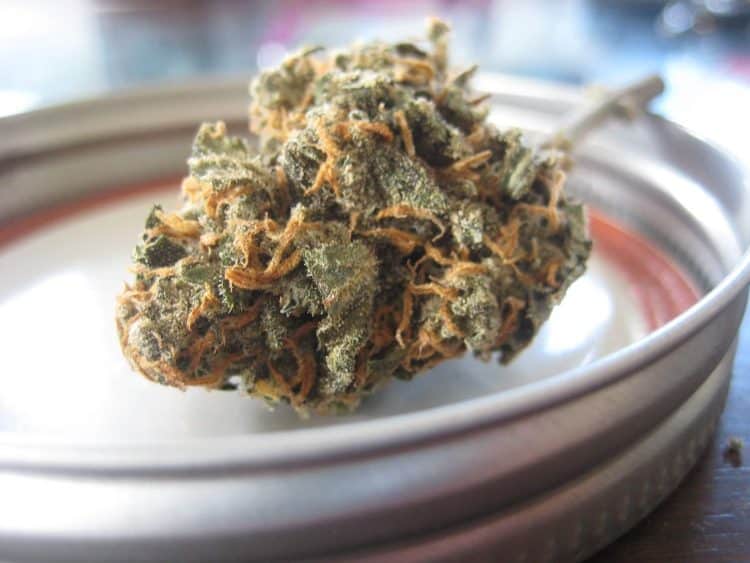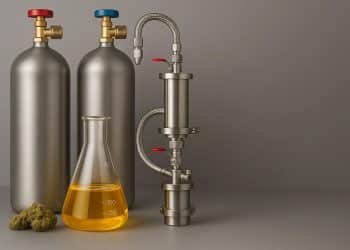While there are a handful of modes of extraction, ‘green’ methods are increasingly being focused on, and the use of deep eutectic solvents (DESs) as extraction solvents for phytocannabinoids has recently been investigated.
Extraction methods separate compounds in cannabis trichomes from plant matter thereby creating extracts or concentrates containing arrays of cannabinoids and terpenes. But certain extraction methods run the risk of toxic residual solvents being left behind, like butane. Eutectic solvents, instead, may potentially produce safer products while also posing minimal risk to environmental and human health.
Use of Eutectic Solvents for Cleaner Extraction
Eutectic solvents are a combination of a hydrogen bond acceptor (HBA) and hydrogen bond donor (HBD) at room temperature. [1] HBDs are often compounds like sugars, amino acids, carboxylic acids (e.g., benzoic acid, citric acid, succinic acid) or amines (e.g., urea, benzamide), and their interaction is key to these solvents’ formation. Halide salts like choline chloride or zinc chloride are also used in conjunction with the HBD. Thanks to the strong hydrogen-bonding interactions, the solvent’s melting point is significantly reduced compared to its standalone components. [2] DESs have low vapor pressures, making them non-flammable. [3] Toxicity levels are low, biodegradability is high, and the precursors used are cheap and renewable. Natural deep eutectic solvents (NDESs) take this a step further with components sourced from natural origin. [1] DESs also offer a tunable solvency based on the chemistry of the solute and the species used to create the DES. [2] A drawback, however, can be the high viscosity of some DESs.
Making extraction of cannabis cannabinoids and other compounds ‘greener’ and more efficient has been a catalyst for innovative extraction methods. The challenge is that many DESs are useful for hydrophilic (attracted to water) species, necessitating more research on the generation of DESs useable for hydrophobic molecules like cannabinoids. A menthol-acetic acid solvent, for example, was shown to be more efficient than methanol, ethanol, and a 9:1 methanol/chloroform solution for extraction of target cannabinoids (e.g., THC) from raw plant material. [4] This study evaluated other terpene alcohols, too, like linalool, geraniol, and borneol. According to Cai et al [5], “extraction of CBD using DESs has the advantages of high extraction yield, simple operation, low cost, and good environmental friendliness, which is potential for the scale-up production.” These researchers evaluated 16 DESs and determined that the combination of choline chloride and (+)-diethyl-L-tartrate provided the highest CBD yields.
As the cannabis industry continues its evolutionary maturation, novel applications for greener extraction solvents will likely increase. The real measures of a technique should assess scalability and yields compared to more traditional ways for cannabinoid and terpene extraction.
Image source: https://pixabay.com/photos/flowers-nature-led-bloom-green-2469212/
References:
- Chemat F, et al. “Review of Alternative Solvents for Green Extraction of Food and Natural Products: Panorama, Principles, Applications and Prospects.” Molecules, vol.24, no.16, 2019, pp. 3007. Journal Impact Factor: 3.060; Times Cited: 17
- Gregorio G. et al. “Deep Eutectic Solvents: Physicochemical Properties and Gas Separation Applications,” Energy & Fuels, vol. 29, no. 4, 2015, pp. 2616–2644. doi:10.1021/ef5028873.
- Smith, E. et al. “Deep Eutectic Solvents (DESs) and Their Applications,” Chem. Rev., vol 114, no. 21, 2014, pp. 11060-11082.
- Křížek T, et al. “Menthol-based Hydrophobic Deep Eutectic Solvents: Towards Greener and Efficient Extraction of Phytocannabinoids.” Journal of Cleaner Production, vol.193, 2018, pp. 391-396. Journal Impact Factor: 6.395; Times Cited: 14
- Cai C, et al. “Green Extraction of Cannabidiol from Industrial Hemp (Cannabis sativa L.) Using Deep Eutectic Solvents Coupled with Further Enrichment and Recovery by Macroporous Resin.” Journal of Molecular Liquids, vol.287, no.110957, 2019, doi:10.1016/j.molliq.2019.110957. Journal Impact Factor: 4.561; Times Cited: 2












